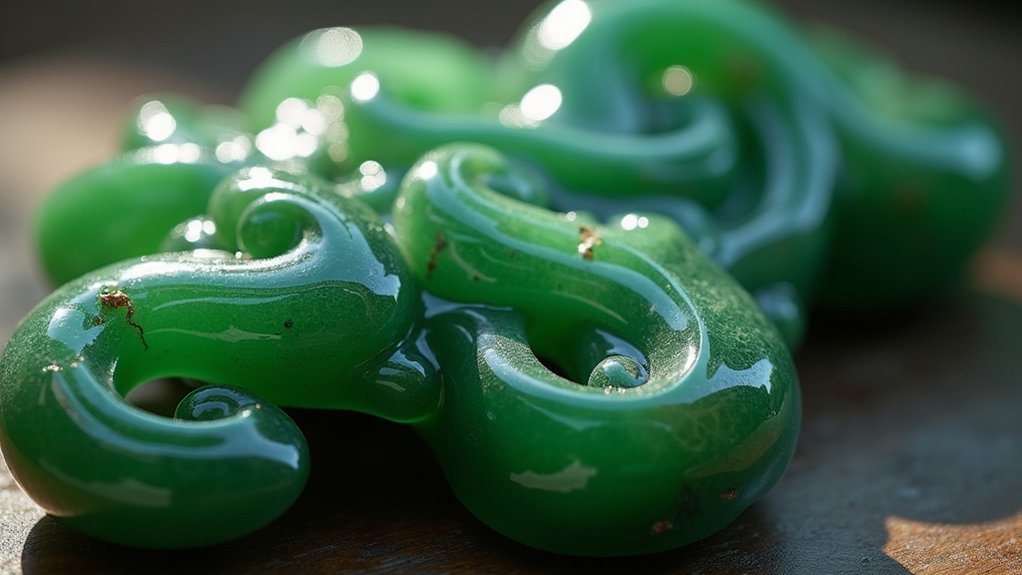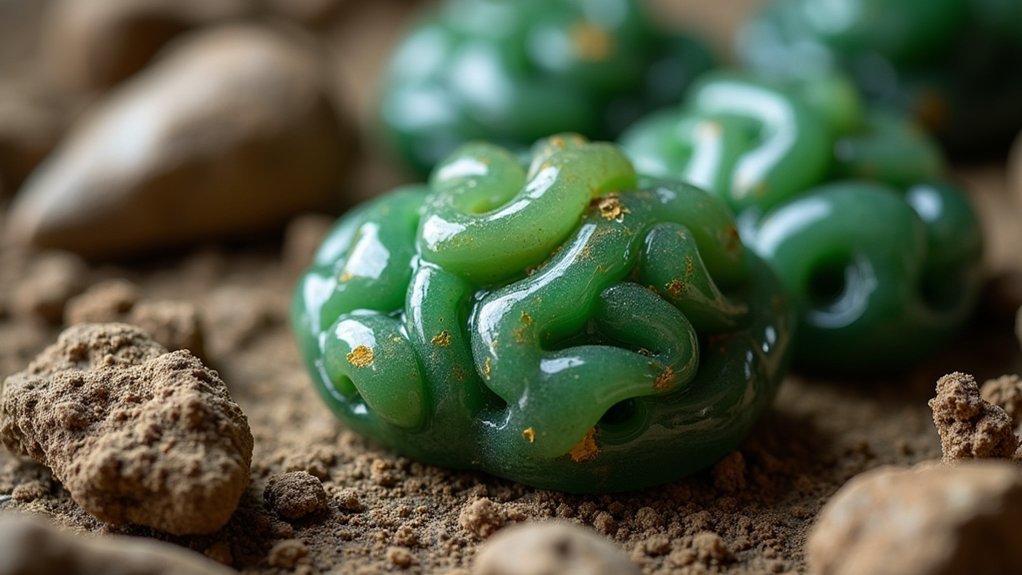When you examine ancient jade jewelry under magnification, you’ll discover carving techniques so sophisticated that modern artisans still struggle to replicate them without advanced machinery. Ancient craftsmen used ingenious string-cutting methods with abrasive jade dust, creating intricate motifs of dragons, phoenixes, and celestial symbols that represented spiritual power and immortality across cultures like Chinese, Mesoamerican, and Māori civilizations. Archaeological discoveries continue revealing how these master artisans achieved such remarkable precision through generations of carefully guarded knowledge.
The Sacred Origins and Cultural Significance of Jade in Ancient Civilizations

When you hold a piece of jade jewelry today, you’re connecting with thousands of years of sacred tradition that spans continents and civilizations.
Ancient Chinese nobility treasured carved jade as symbols of immortality, incorporating these precious stones into burial practices to honor the deceased. In Mesoamerica, jade represented purity and spiritual power, while Māori culture revered pounamu as taonga—treasures passed down through generations to preserve ancestral heritage.
Across civilizations, jade transcended ornamental beauty to embody immortality, purity, and ancestral wisdom in sacred cultural traditions.
The cultural significance of jade extends beyond mere decoration.
Artisans embedded spiritual symbols and nature motifs into their intricate carvings, creating pieces that expressed social status and spiritual beliefs. Each carved jade artifact served as a bridge between the physical and spiritual worlds, transforming simple stones into powerful talismans that connected wearers to their cultural identity and the natural universe.
Traditional Carving Techniques and Tools Used by Ancient Artisans
You’ll discover that ancient jade artisans crafted their tools from harder materials like stone and metal, creating chisels and drills capable of working the incredibly tough nephrite jade.
They’d employ ingenious string-cutting methods combined with abrasive jade dust and sand to slowly shape and polish their pieces to perfection.
These master craftsmen passed their specialized techniques through generations, ensuring each culture developed its own distinctive carving styles and decorative motifs.
Ancient Tool Materials
Mastery of jade carving began with the careful selection of tools crafted from the earth’s most enduring materials.
You’ll find that ancient artisans relied on wood, stone, and metal to create their specialized implements. These carving techniques demanded tools that could withstand constant friction against jade’s renowned hardness.
Your understanding of their craft deepens when you consider how they fashioned primary shaping tools from harder stones and metals.
These hand-held abrasive instruments allowed precise control over each jade pendant’s intricate details. Metal tools provided superior durability, while stone offered natural abrasive qualities essential for grinding operations.
Wood served vital structural purposes, particularly in bow drill construction.
These hand-powered devices featured rotating tips that carved detailed holes and patterns, demonstrating how ancient artisans maximized each material’s unique properties.
String and Dust Methods
While harder materials shaped jade’s basic form, ancient artisans achieved their most delicate work through an ingenious combination of string, animal fat, and jade dust. You’d find these craftsmen using bow drills powered by strings to carve precise details that remind us of nature’s complexity. The jade dust acted as an abrasive agent mixed with animal fat, creating a grinding compound that allowed for intricate spiritual motifs.
| Component | Function | Application |
|---|---|---|
| String | Power transmission | Bow drill operation |
| Animal fat | Binding agent | Dust suspension |
| Jade dust | Abrasive medium | Fine detailing |
| Bow drills | Precision cutting | Complex designs |
| Generational knowledge | Skill preservation | Technique mastery |
When you agree to receiving this ancient wisdom, you’ll understand how each carved piece earned rights reserved for sacred objects, embodying cultural reverence through masterful technique.
Generational Skill Transfer
Although modern apprenticeships often rely on formal instruction, ancient jade carving masters transmitted their knowledge through intimate family bonds and carefully observed practice sessions.
You’d witness young artisans spending years mastering the delicate balance between pressure and precision, learning to read jade’s unique grain patterns and natural inclusions. They’d inherit not just tools, but generations of accumulated wisdom about which abrasives worked best for specific cuts and how to manipulate light across polished surfaces.
You’d observe master craftsmen demonstrating the subtle wrist movements needed for intricate hand-carving, while apprentices absorbed the cultural philosophy that emphasized jade’s inherent beauty.
This generational transfer guaranteed that specialized techniques for grinding and polishing survived centuries, maintaining the exceptional standards that defined ancient jade artistry.
Symbolic Motifs and Natural Inspirations in Jade Jewelry Design
You’ll discover that ancient jade artisans drew their most powerful inspiration from the natural world around them, translating flora, fauna, and celestial phenomena into intricate carved patterns.
These craftsmen didn’t simply create decorative elements—they embedded sacred animal motifs like dragons, phoenixes, and tigers that carried profound spiritual meanings within their cultures.
When you examine these pieces closely, you’ll notice how celestial symbols representing clouds, stars, and cosmic forces weren’t just artistic choices but reflected the artisans’ deep reverence for the connection between earthly beauty and heavenly power.
Nature-Inspired Carving Patterns
Every jade carving tells a story through nature’s language, with ancient artisans drawing endless inspiration from the world around them to create symbolic motifs that transcend mere decoration.
When you examine these masterpieces, you’ll discover how craftsmen transformed jade’s natural beauty into intricate designs that captured the essence of their surrounding environment. They didn’t simply copy nature—they interpreted its deeper meanings through their skilled hands.
The most enchanting nature-inspired patterns include:
- Swirling clouds that represent the connection between earthly and celestial domains
- Mythical creatures like dragons and phoenixes symbolizing power and rebirth
- Intricate floral motifs reflecting the artists’ profound reverence for botanical beauty
Through meticulous carving, grinding, and polishing techniques, these artisans highlighted jade’s natural color variations while embedding cosmological beliefs into every curve and line.
Sacred Animal Motifs
When ancient jade carvers sought to infuse their creations with divine protection, they turned to sacred animal motifs that served as powerful spiritual guardians.
You’ll find dragons and phoenixes dominating these intricate carvings, each carrying profound symbolic weight. Dragons embodied power and strength, while phoenixes represented rebirth and harmony in ancient mythology.
These artisans didn’t simply copy nature—they captured its spiritual essence. You’d wear these carved talismans believing they’d ward off evil spirits and attract good fortune. The protective properties weren’t just decorative choices; they were deliberate spiritual investments.
The sophisticated artistry demonstrates how carvers bridged physical and spiritual domains.
You’re witnessing craftsmanship that showcased technical skill while conveying deep cultural reverence for nature’s sacred creatures.
Celestial Symbol Meanings
Beyond earthbound creatures, ancient jade carvers elevated their artistry by capturing the cosmos itself within precious stone.
You’ll discover that celestial motifs weren’t merely decorative choices—they embodied profound spiritual beliefs about the universe’s influence on human destiny.
When you examine jade celestial symbols, you’re witnessing ancient wisdom carved in stone:
- Sun, moon, and star motifs – These represent cosmic forces believed to govern fortune and fate.
- Jade cong artifacts – Symbolic bridges connecting earthly existence with heavenly domains.
- Swirling cloud patterns with mythical beings – Expressions of harmony between natural and spiritual worlds.
Artisans skillfully exploited jade’s natural colors and textures, using sophisticated shading techniques to create ethereal effects.
These celestial carvings transcended ornamentation, serving as tangible connections to cosmic beliefs and cultural reverence for heavenly powers.
The Spiritual and Ceremonial Roles of Jade Ornaments
Throughout history, jade ornaments have served as powerful conduits between the physical and spiritual domains, carrying deep ceremonial significance that transcends mere decoration.
You’ll find that ancient Chinese cultures incorporated jade artifacts into rituals and ancestral worship, believing these pieces connected the living with spirit worlds. When you examine the iconic jade cong, you’re witnessing representations of heaven and earth’s union, reflecting profound cosmological beliefs.
You’ll discover that craftsmen carved intricate mythical creatures and natural motifs into jade pieces, creating protective talismans for life’s significant moments.
These ornaments embodied purity, longevity, and spiritual power across various cultural ceremonies. Today, you can still observe jade’s ceremonial importance in modern interpretations that honor this material’s enduring spiritual significance and rich cultural heritage.
Archaeological Discoveries Revealing Hidden Jade Craftsmanship Secrets

Recent archaeological excavations have unearthed remarkable jade artifacts that reveal sophisticated craftsmanship techniques previously unknown to modern scholars.
You’ll discover that ancient artisans mastered complex methods that showcase their extraordinary skill and cultural understanding.
These discoveries reveal three key aspects of hidden jade craftsmanship:
Archaeological findings illuminate three fundamental elements of ancient jade artisanship that demonstrate remarkable technical mastery and deep cultural significance.
- Advanced Technical Methods – You’ll find evidence of intricate carving, grinding, and polishing techniques that created stunning jewelry pieces with precision that rivals modern technology.
- Symbolic Design Integration – You’ll see how artisans embedded cultural beliefs into specific motifs, linking spiritual significance directly to societal status through carefully planned designs.
- Protective Inscription Practices – You’ll notice many pieces contain inscribed symbols and texts that served as spiritual talismans, conveying lineage information and protective messages across generations.
Preservation and Authentication Methods for Ancient Jade Artifacts
The extraordinary jade artifacts you’ve learned about from archaeological discoveries face immediate threats once they’re unearthed, making their preservation a race against time.
You’ll find that conservators blend traditional restoration techniques with cutting-edge technology to maintain each piece’s integrity. They carefully control environmental factors like humidity and temperature during storage and handling.
Authentication requires your attention to craftsmanship details, materials analysis, and historical context research.
Museums employ specialized collection management services to acquire, appraise, and display these treasures accurately.
You can’t overlook how technological advancements continuously improve preservation methods, allowing deeper understanding of jade’s cultural significance.
Each authenticated piece reveals secrets about ancient civilizations while ensuring future generations can appreciate these remarkable artistic achievements.
Frequently Asked Questions
Are Jade Carvings Worth Anything?
You’ll find jade carvings can be extremely valuable, especially with quality craftsmanship and imperial green jade. You’re looking at prices from hundreds to millions, depending on authenticity, rarity, and cultural significance.
What Does the Jade Pendant Connect With Ancient Times?
You’ll discover the jade pendant connects you to Maya king Janaab Ohl Kinich’s reign, 647 AD political events, ancient burial customs, spiritual beliefs, and royal dynasties, revealing how jade symbolized power and identity in Maya civilization.
How Can You Tell if Jade Is Carved?
You can tell if jade’s carved by examining the surface for fine details, smooth polished areas, natural inclusions, subtle tool marks, and feeling its warm texture while listening for its distinct sound when tapped.
What Is the Significance of Jade Carving?
You’ll find jade carving represents purity, longevity, and spiritual power across ancient civilizations. It’s connected cosmological beliefs with physical reality, served in ancestral worship, and continues preserving cultural identity today.
In Summary
You’ve journeyed through millennia of jade artistry, discovering how ancient craftsmen transformed raw stone into sacred treasures. You’ve learned their secret techniques, understood the spiritual meanings behind each carved symbol, and witnessed archaeology’s remarkable revelations. Now you can appreciate jade jewelry’s profound cultural legacy and recognize authentic pieces. You’re equipped to see beyond mere ornaments—you understand jade’s role as a bridge between earthly beauty and divine significance.





Leave a Reply